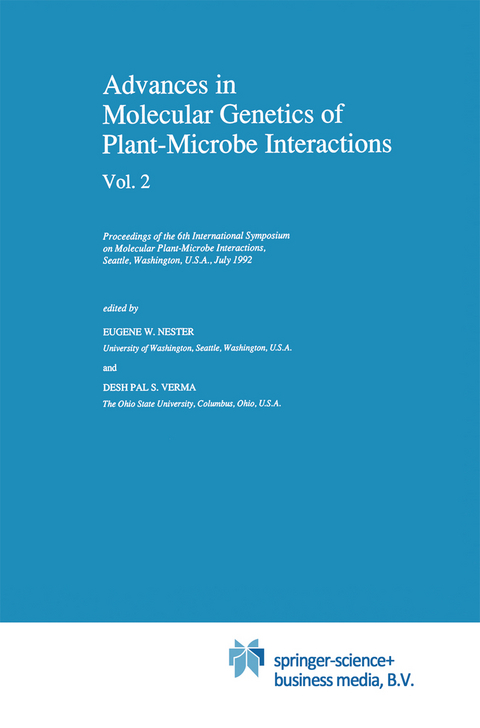
Advances in Molecular Genetics of Plant-Microbe Interactions, Vol. 2
Springer (Verlag)
978-90-481-4221-7 (ISBN)
Research on Plant-Microbe Interactions: Making it relevant.- Cell-cell interactions during pollination in Brassica.- Overcoming pest and pathogen adaptability using insights from evolutionary biology.- The Virulence System of Agrobacterium tumefaciens.- Molecular and chemical analysis of signal perception by Agrobacterium.- A. Tumefaciens T-DNA transport: Roles for VirB, VirD2 and VirE2.- Identification of genetic factors controlling the ability of Agrobacterium to transfer DNA to maize.- Mechanism of T-DNA transfer.- Molecular interactions between Agrobacterium and plant cells.- Detection of avirulent mutants of Agrobacteriumtumefaciens in crown-gall tumors produced in vitro.- VirB4 is an inner membrane-associated protein essential for T-DNA transfer from Agrobacterium tumefaciens to plants.- The Rhizogenes tale: modification of plant growth and physiology by an enzymatic system of hydrolysis of phytohormone conjugates.- The Agrobacterium tumefaciens transcriptional activator OccR causes a bend at a target promoter that is partially relaxed by plant tumor metabolite.- Rhizobium nodulation factors: variations on a theme.- Control of nodule induction and plant cell growth by nod factors.- Rhizobial lipo-oligosaccharide signals: their biosynthesis and their role in the plant.- NodO: A nodulation protein that forms pores in membranes.- Nonflavonoid inducers of nod genes in Rhizobium meliloti: apparent NODD2 activators released naturally from alfalfa seeds add new dimensions to rhizosphere biology.- Role in nodulation and genetic regulation of exopolysaccharide synthesis in Rhizobium meliloti.- Oxygen regulation of nitrogen fixation gene expression in Rhizobiummeliloti.- Oxygen sensing and protein phosphorylation by the two-component regulatory FIXLJ system from Rhizobium meliloti.- Genetic and physiologic requirements for optimal bacteroid function in the Bradyrhizobium japonicum soybean symbiosis.- Determinants of specificty in the interaction of plants with bacterial pathogens.- A family of avirulence genes from Xanthomonasoryzae pv. Oryzae is involved in resistant interactions in rice.- Further characterization of genes encoding extracellular polysaccharide of Pseudomonas solanacearum and their regulation.- Physiological and genetic regulation of a pectate lyase structural gene, pel-I of Erwinia carotovora subsp. carotovora strain 71.- Oxidative stress response in Xanthomonas oryzae.- Involvement of Pseudomonas Solanacearumhrp genes on the secretion of a bacterial compound which induces a hypersensitive-like response on tobacco.- Pseudomonas syringae pv. phaseolicola-plant interactions: Host-pathogen signalling through cascade control of hrp gene expression.- Molecular genetic analysis of hrp and avirulence genes of Xanthomonascampestris pv. Vesicatoria.- Are harpins universal elicitors of the hypersensitive response of phytopathogenic bacteria?.- Molecular cloning and functions of avirulence and pathogenicity genes of the tomato pathogen Cladosporium fulvum.- Genome dynamics and pathotype evolution in the rice blast fungus.- Molecular basis of specificity in maize leaf spot disease.- The genetics of dimorphism in the smut fungi.- Genetical and functional organization of the a mating type locus of Ustilagomaydis.- Root nodule organogenesis and formation of the peribacteroid membrane compartment.- Early events in alfalfa nodule development.- Rhizobium nod metabolites and early nodulin gene expression.- Mechanisms of cell and tissue invasion by Rhizobium leguminosarum: The role of cell surface interactions.- Control of infection in thealfalfa-Rhizobium memiloti symbiosis.- Induction of genes encoding phenylpropanoid biosynthetic enzymes in soybean roots inoculated with B.japonicum, requires NOD gene induction and occurs independent of any known host functions.- Analysis of the Arabidopsis defense response to Pseudomonas pathogens.- Genetic approaches to an understanding of specific resistance responses of Arabidopsis thaliana against phytopathogenic Pseudomonads.- Identification of an Arabidopsis locus that governs avirulence gene-specific disease resistance.- Plant and bacterial genes involved in interactions between Xanthomonas and crucifers.- The identification and mapping of loci in Arabidopsis thaliana for recognition of the fungal pathogens: Peronospora parasitica (downy mildew) and Albugo candida (white blister).- Screening methods for Arabidopsis mutants affected in the signal transduction pathways leading to defense responses.- Towards positional cloning of the Pto bacterial resistance locus from tomato.- Studies on the mechanism by which tomato Cf (Cladosporium fulvum) resistance genes activate plant defence.- Molecular biology and biochemistry of Hml, a maize gene for fungal resistance.- Transposon tagging of a rust resistance gene in maize.- Glucan elicitor-binding proteins and signal transduction in the activation of plant defence.- Elicitor recognition and intracellular signal transduction in plant defense.- Transcriptional regulation of phytoalexin biosynthetic genes.- Mutagenesis of a race-specific rust resistance gene in Antirrhinum majus using a transposon-tagging protocol.- Molecular markers and genome analysis in the manipulation of lettuce downy mildew.- Systematic acquired resistance in tobacco: Use of transgenic expression to study the functions of pathogenesis-related proteins.- Genetic and biochemical determinants of phenazine antibiotic production in fluorescent pseudomonads that suppress take-all disease of wheat.- A biological sensor for iron that is available to Pseudomonas fluorescens inhabiting the plant rhizosphere.- Characteristics and applications of antibodies produced in plants.- Application of microinjection technique for the analysis of gene expression during host-parasite interaction.- Resistance to Rhizoctonia solani in transgenic tobacco.- Antibacterial resistance of transgenic potato plants producing T4 lysozyme.- Pathogen-derived strategy to produce transgenic plants resistant to the bacterial toxin phaseolotoxin.- A universally conserved vital protein revealed by victorin binding.- Nitrogen fixation of Azorhizobium in artificially induced root para-nodules in wheat.- Name Index.
| Reihe/Serie | Current Plant Science and Biotechnology in Agriculture ; 14 |
|---|---|
| Zusatzinfo | XII, 622 p. |
| Verlagsort | Dordrecht |
| Sprache | englisch |
| Maße | 155 x 235 mm |
| Themenwelt | Naturwissenschaften ► Biologie ► Botanik |
| ISBN-10 | 90-481-4221-0 / 9048142210 |
| ISBN-13 | 978-90-481-4221-7 / 9789048142217 |
| Zustand | Neuware |
| Haben Sie eine Frage zum Produkt? |
aus dem Bereich


